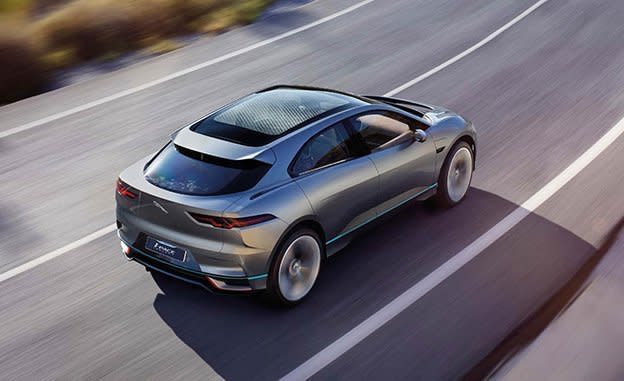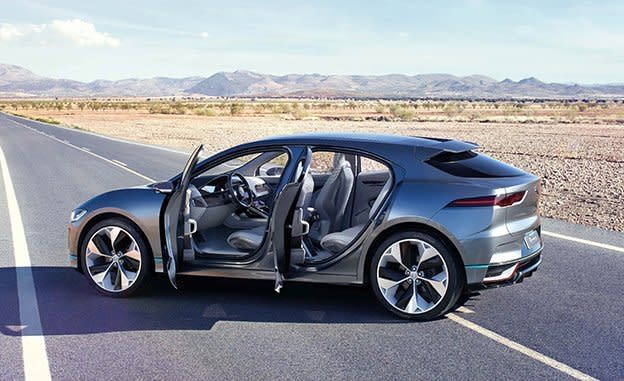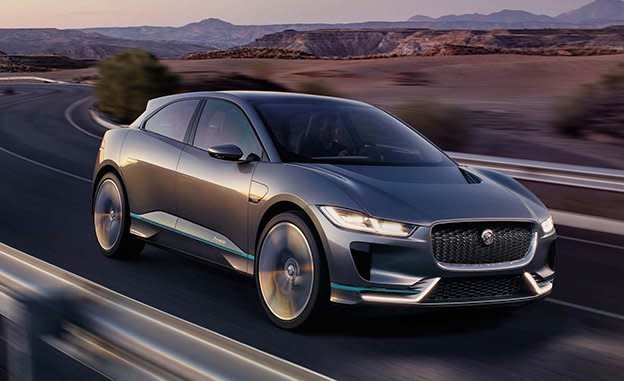Jaguar I-Pace Concept: 400 HP, All-Wheel Drive, Coming in 2018

Few descriptors in the automotive realm can match the versatility of the word “concept.” Often manufacturers slap it on not-quite-fully-baked vehicles to gauge public opinion, leaving plenty of leeway to redesign or abandon any project that fails to excite. That’s not the case with Jaguar’s new I-Pace EV concept. As Ian Callum, Jaguar’s director of design, boldly proclaimed: “This isn’t just a concept. It is a preview of a five-seat production car that will be on the road in 2018.”
The appearance of an all-electric Jaguar is not entirely a surprise. Word has been circulating for some time that the automaker was developing an EV platform that could be used for both an SUV and a sedan. There also have been reports of a pending fully electric version of the F-Pace. Jaguar says the I-Pace is built on a dedicated electric-vehicle architecture that allowed the designers to “tear up the rulebook on vehicle layout,” as the company put it.

Inching toward Efficiency
The dimensions do support the assertion that I-Pace is more than just an F-Pace with a pair of electric motors and a battery pack secured in its nether regions. For example, the I-Pace’s 117.7-inch wheelbase is more than four inches longer than that of the F-Pace, but the I-Pace’s 184.3-inch overall length is approximately two inches shorter. This not only provides plenty of room to package the liquid-cooled 90-kWh lithium-ion battery pack between the axles, it also encouraged Jaguar’s designers to pursue a cab-forward design that is said to be inspired by the C-X75 supercar. One look at the heavily sculpted hood, gray finish, and steeply raked windshield, and it’s clear that the team gave at least passing thought to that 2010 concept. The balance of the measurements peg the I-Pace as slightly smaller than the F-Pace: At 61.4 inches high, the I-Pace is almost four inches lower than the F-Pace, and its 74.4-inch width makes it almost two inches narrower. A claimed 0.29 drag coefficient, bettering the F-Pace’s 0.37 Cd significantly, was achieved with the help of flush door handles, a C-X75–inspired flow-through hood scoop, an aerodynamically optimized rear end, and side skirts.
Like many production Jaguars, the I-Pace uses an unequal-length control-arm front suspension, with Jaguar citing the superior geometry afforded by the layout. Similarly, the rear shares the independent layout currently used by the F-Pace and the XF and XE sedans.
Home on the Range
With the new Chevrolet Bolt offering better than 200 miles of range for under $40,000 (before tax credits), any legitimate entry into the EV market from this point forward needs to hit the magic 200-mile range marker to be taken seriously. At this early stage, Jaguar is claiming “in excess of” 220 miles of range for the I-Pace. More impressive is the claimed 4.0-second zero-to-60-mph time. Motivation comes from a pair of permanent-magnet AC motors; one is integrated in each axle. Each produces 200 horsepower and 258 lb-ft of torque, for totals of 400 horsepower and 516 lb-ft.

Rather than look to an outside supplier or a partner to build the electric motors, Jaguar took on the task internally. What it came up with is a pair of synchronous motors, 9.2 inches in diameter and 19.7 inches long. Using a concentric arrangement with one side’s driveshaft passing through the motor rather than a traditional offset layout, Jaguar says, offers packaging efficiency, weight savings, more ground clearance, and maximum interior space. Jaguar also says it has dialed in plenty of regenerative braking, which not only increases range but also permits one-pedal driving, using which the driver can slow the vehicle to a stop simply by lifting off the accelerator. Drivers can select the level of regenerative braking via the D button. In addition to the all-wheel drive provided by the electric motors, the I-Pace features Jaguar’s All Surface Progress Control and Adaptive Surface Response software to provide optimal traction in varying environments.
Like the motors, the battery pack also is designed in-house. Encased in an aluminum housing that does double duty as a part of the vehicle’s structure, the 90.0-kWh unit is composed of 36 modules, containing prismatic (pouch type) cells. Claims made for the nickel-manganese-cobalt chemistry used here are superior energy density, lighter weight, and improved thermal-management characteristics versus other lithium-ion battery designs.
A thermal-management system maintains optimal battery operating temperatures. This system’s integral heat pump scavenges heat from the outside air to help warm the vehicle’s interior. This function can deliver a claimed double-digit increase in range, even in freezing ambient temperatures. Estimates peg the recharge cycle at 90 minutes to achieve 80 percent of capacity using a 50-kW DC fast charger.

Stylistically Speaking
Complementing the I-Pace’s contemporary, muscular styling and sloping roofline exterior is a set of 23-inch Nighthawk wheels finished in gray and shod with 265/30-series tires with a unique tread pattern. Slim LED headlamps light the way forward, and a special hydrophobic coating on the steeply raked rear window allegedly eliminates the need for a rear wiper. A slender composite rear spoiler is said to reduce lift at high speeds with minimal effect on aerodynamic drag. Finally, a rear diffuser and a set of rear vents that replace actual exhaust finishers supposedly employ turbulence to reduce drag.
The interior is another indicator of how close to production the I-Pace is. Once again, Jaguar points to the freedom provided by the EV powertrain, with Callum stating: “Our brief was to create a spacious performance SUV that could carry five people. Otherwise we had a clean sheet of paper.” It is this freedom of design that permits 19 cubic feet of cargo space plus a bonus one cubic foot of storage under the sculpted front hood.
The seating position is lower than in traditional SUVs, as is the mounting position of the instrument panel, which features minimal switchgear. The center-stack console’s two-strut design looks clean, offers almost 500 cubic inches of storage underneath, and is said to be a precursor of a design element that will filter into future Jaguar products. A full-length panoramic glass roof features an array of embedded LEDs that illuminate for visual effect. Materials are up to Jag standards: Windsor leather covers the seating surfaces, open-pore walnut veneer and aluminum highlight the door trim, and there is a copious amount of microsuede throughout.

The physical switchgear seeks to blend tactile feel with digital technology. The primary interface is a 10.0-inch TFT screen in the center console. To keep essential information such as navigation uncluttered, a second, 5.5-inch display resides below it, allowing occupants to fiddle with climate and infotainment functions separately. Meanwhile, a configurable 12.0-inch virtual instrument cluster and head-up display put the crucial info in plain sight for the driver. Jag’s InControl Apps permit iOS and Android smartphone functionality, and a Wi-Fi hotspot gives passengers the option of tuning out reality completely.
The critical comparison here, of course, is to the Tesla Model X. Although the I-Pace’s wheelbase is exactly an inch longer than the Model X’s, the I-Pace is five inches lower and 14 inches shorter in length. Sizewise, the I-Pace appears to occupy the middle ground between the Model X and a possible Model 3–based crossover. The I-Pace’s claimed 220-mile range is within sight of the Model X’s 250-mile EPA-rated figure, yet by Jag’s estimate the I-Pace won’t match the Tesla’s 3.3-second zero-to-60-mph time. Until a production version appears and full pricing and EPA estimates are available, all comparisons are speculative. Should it significantly undercut the falcon-winged upstart, however, the I-Pace is likely to have little trouble diverting upscale EV buyers to a Jaguar showroom.


 Yahoo Autos
Yahoo Autos 